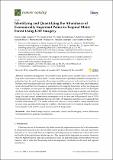Files in this item
Identifying and quantifying the abundance of economically important palms in tropical moist forest using UAV imagery
Item metadata
| dc.contributor.author | Tagle Casapia, Ximena | |
| dc.contributor.author | Falen, Lourdes | |
| dc.contributor.author | Bartholomeus, Harm | |
| dc.contributor.author | Cardenas, Rodolfo | |
| dc.contributor.author | Flores, Gerardo | |
| dc.contributor.author | Herold, Martin | |
| dc.contributor.author | Honorio Coronado, Euridice N. | |
| dc.contributor.author | Baker, Timothy R. | |
| dc.date.accessioned | 2022-01-25T11:30:03Z | |
| dc.date.available | 2022-01-25T11:30:03Z | |
| dc.date.issued | 2020-01 | |
| dc.identifier | 276941020 | |
| dc.identifier | 4a0ae115-7880-4c14-bc6b-6afb45458c05 | |
| dc.identifier | 000515391700009 | |
| dc.identifier | 85079676519 | |
| dc.identifier.citation | Tagle Casapia , X , Falen , L , Bartholomeus , H , Cardenas , R , Flores , G , Herold , M , Honorio Coronado , E N & Baker , T R 2020 , ' Identifying and quantifying the abundance of economically important palms in tropical moist forest using UAV imagery ' , Remote Sensing , vol. 12 , no. 1 , 9 . https://doi.org/10.3390/rs12010009 | en |
| dc.identifier.issn | 2072-4292 | |
| dc.identifier.other | ORCID: /0000-0003-2314-590X/work/104252817 | |
| dc.identifier.uri | https://hdl.handle.net/10023/24744 | |
| dc.description.abstract | Sustainable management of non-timber forest products such as palm fruits is crucial for the long-term conservation of intact forest. A major limitation to expanding sustainable management of palms has been the need for precise information about the resources at scales of tens to hundreds of hectares, while typical ground-based surveys only sample small areas. In recent years, small unmanned aerial vehicles (UAVs) have become an important tool for mapping forest areas as they are cheap and easy to transport, and they provide high spatial resolution imagery of remote areas. We developed an object-based classification workflow for RGB UAV imagery which aims to identify and delineate palm tree crowns in the tropical rainforest by combining image processing and GIS functionalities using color and textural information in an integrative way to show one of the potential uses of UAVs in tropical forests. Ten permanent forest plots with 1170 reference palm trees were assessed from October to December 2017. The results indicate that palm tree crowns could be clearly identified and, in some cases, quantified following the workflow. The best results were obtained using the random forest classifier with an 85% overall accuracy and 0.82 kappa index. | |
| dc.format.extent | 26 | |
| dc.format.extent | 8307808 | |
| dc.language.iso | eng | |
| dc.relation.ispartof | Remote Sensing | en |
| dc.subject | Object-based image analysis | en |
| dc.subject | Unmanned aerial vehicles imagery | en |
| dc.subject | Crown delineation | en |
| dc.subject | Textural parameters | en |
| dc.subject | Palm tree identification | en |
| dc.subject | G Geography (General) | en |
| dc.subject | 3rd-DAS | en |
| dc.subject.lcc | G1 | en |
| dc.title | Identifying and quantifying the abundance of economically important palms in tropical moist forest using UAV imagery | en |
| dc.type | Journal article | en |
| dc.contributor.institution | University of St Andrews. School of Geography & Sustainable Development | en |
| dc.identifier.doi | 10.3390/rs12010009 | |
| dc.description.status | Peer reviewed | en |
This item appears in the following Collection(s)
Items in the St Andrews Research Repository are protected by copyright, with all rights reserved, unless otherwise indicated.

